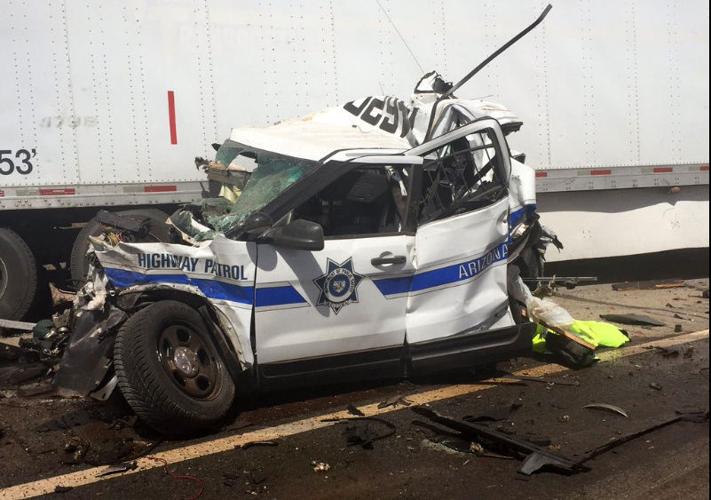State authorities have reduced the speed limit on a stretch of Interstate 10 near the New Mexico border from 75 mph to 45 mph after two dust storms caused pileups this week.
Officials also vow to act more quickly to close that stretch when needed as long as a tract of land denuded for agriculture remains in its current state.
Crashes on Monday and Thursday occurred in the same area around milepost 376 between Bowie and San Simon where land was stripped of vegetation last year. Dust also caused a two-vehicle crash at the site on April 7, said Bill Harmon, engineer for the Arizona Department of Transportation’s southeast district.
Officials from ADOT and the Arizona Department of Public Safety met with their New Mexico counterparts Friday to discuss strategies for dealing with the recurring problem.
“We’re going to be shutting the interstate down sooner. We’re not going to be taking any chances,” said Trooper Kameron Lee, a state DPS spokesman.
In Thursday’s pileup, a DPS squad car was crushed by a semitrailer truck. Sgt. Stewart Shupe was out of his car directing traffic around an accident at the time and was not injured.
“We did not get it closed in time before those accidents happened,” Lee said.
On Thursday, 13 vehicles were involved in three separate crashes. Only three minor injuries were reported, Lee said. On Monday, a three-vehicle crash left a truck driver seriously injured.
“So far we’ve been fortunate there have been no fatalities,” said Harmon.
Lee said officials were told at Friday’s meeting that dust from the recently disturbed desert plot south of Interstate 10 can become airborne if the wind is blowing at 15 mph.
The National Weather Service recorded gusts up to 45 mph in the area on Monday and Thursday.
UA meteorologist Mike Leuthold, who travels that stretch of highway regularly, said he witnessed dust blowing across the road in mild winds this winter.
“I said, ‘This is going to be a problem.’ They bladed the desert completely of all vegetation in preparation for planting groves.” Leuthold estimated the plot to be about 200 acres.
State officials have not yet identified the owner of the land, but plan to do so quickly and urge mitigation measures. They have no legal authority to require them, said Harmon.
“We don’t have much leverage or influence in that regard. Right now, we’re working with the Cochise County Assessor’s Office to see if we can find the owner. We’d like to find out what they’re going to do, crops or orchards or whatever.”
Lynne Taylor, who commutes between homes in Tucson and Portal along Interstate 10, said she has recently encountered “billowing dust clouds” at the spot on windless days, when tractors were operating there.
On Thursday she drove through dust again, after the accidents had occurred, but before the detour was enacted.
“I find it frightening that public safety on an interstate highway is not being looked after because of pecan fields. If I owned that land, I would be absolutely dismayed by what I had done.”
Leuthold said the growing number of orchards along Interstate 10 in the Bowie/San Simon area help cut down dust, when they are irrigated and mature.
Denuded land, however, is a dust storm waiting to happen. In addition, the area is “an extremely windy spot” on the lee side of the Chiricahua Mountains where winds “accelerate downslope,” Leuthold said.
The decision to close the interstate is not made lightly and is not easy to do, said Lee. It forces a 110-mile detour north on US 191 to Safford, then east on US 70 to Lordsburg, New Mexico.
Lee said DPS personnel were headed to the Arizona 191 intersection Thursday to close it while Sgt. Shupe was trying to slow traffic that had already passed the detour point.
He was tending to a crash in the eastbound lane when cars started piling up westbound. He crossed over the median and was moving cars off the road when his squad car was hit by the semi-truck, Lee said.
A San Simon Fire District emergency vehicle was also involved in a collision.
The crashes occurred in an area where the Arizona Department of Transportation has installed sensors to monitor visibility and electronic message boards to warn motorists. Those systems were operating Thursday, Lee said, but a low-frequency radio station that broadcasts highway information was not.
The crash-prone area is between two of ADOT’s sensors. Harmon said an ADOT employee has been assigned to patrol that stretch of highway.
Harmon said ADOT and DPS have agreed to “preemptively shut down traffic once we’ve seen precursor conditions.”
“Our observation is that the dust is generated at a somewhat lower wind velocity than in other areas,” he said.
The National Weather Service office in Tucson had warned of blowing dust in its weather advisory early Thursday, as it had the Monday before. ADOT spokesman Doug Nintzel said electronic message signs warning of the danger were activated both mornings.
DPS, ADOT and weather service offices in Tucson and Phoenix have been meeting for five years to find ways to avoid crashes caused by blowing dust.
Ultimately, the problem is one of historically degraded or recently disturbed agricultural land.
Harmon said an electronic message board warning of the danger caused by the field has been installed at either end of the five-mile stretch with the 45 mph speed limit.
Nintzel noted that it’s not the only stretch of the interstate where dust-caused accidents occur, and motorists should heed the department’s “Pull Aside, Stay Alive” message.
“Dust storms and dust channels can occur in a number of areas across the state. We’re getting into a general time of the year when they are likely to occur and can happen at any time,” he said.
“If you’re caught with zero- or near-zero visibility, pull off the right side of the pavement, if possible. Turn off your lights and take your foot off the brake pedal.”








